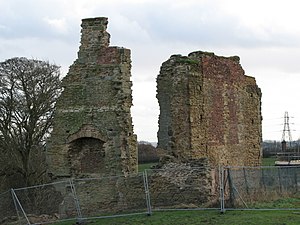Codnor Castle
| Codnor Castle | |
|---|---|
| Aldercar and Langley Mill, Amber Valley, Derbyshire | |

Remains of Codnor Castle, viewed from the north-west.
|
|
| Coordinates | 53°02′43″N 1°21′17″W / 53.0454°N 1.3548°W |
| Site information | |
| Condition | Ruined |
| Site history | |
| Built | 13th century |
| Materials | stone |
| Official name | Codnor Castle |
| Reference no. | 1007047 |
|
Listed Building – Grade II
|
|
| Official name | Remains of Codnor Castle, Castle Lane |
| Designated | 25 November 1963 |
| Reference no. | 1109025 |
| Managed by | The Codnor Castle Heritage Trust |
| Website | http://www.codnorcastle.co.uk/ |
Codnor Castle is a ruined 13th-century castle in Derbyshire, England. The land around Codnor came under the jurisdiction of William Peverel after the Norman conquest. Although registered as a Scheduled Ancient Monument and Grade II Listed Building the site is officially, as at 2016, a Building at Risk.
The castle is a stone keep and bailey fortress and was established by William Peverel. The present fragmentary remains represent a three-storey keep and a strong curtain wall and ditch, flanked by round towers. The outer bailey is on a lower level and was constructed at a later period. The castle overlooks the Erewash valley and the counties of Derbyshire and Nottinghamshire. It originally had a deep moat and on its eastern side there was once a considerable abundance of trees, which have now been cut down. On the west side there was a courtyard that was strongly fortified by huge round towers, which had battlements. In other parts of the ruins there is evidence that the outer walls had loopholes included to allow bowmen to use them if necessary.
By 1211 it was owned by Henry de Grey, a descendant of the Norman knight Anchetil de Greye. Henry's descendants include the long line of Lords Grey of Codnor, the Lords Grey of Ruthyn, Wilton and Rotherfield, Lady Jane Grey and the Earls of Stamford, and the extinct families of the Dukes of Suffolk and Kent. His son Richard settled in Codnor and was a loyal Baron to Henry III. Along with his brother John they served the King in the Holy Land. John Grey distinguished himself in the Scottish wars and found himself in great favour with Edward III. Together with William D'Eincourt, the Lord Grey commanded all the knights of Derbyshire and Nottinghamshire in case of an invasion. Henry the last of the family, died during the reign of Henry VII, without a legitimate heir. He left part of his lands to his illegitimate sons, Henry and Richard, and part to his widow, Katherine Stourton.
...
Wikipedia

